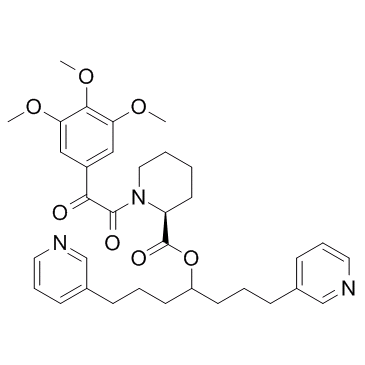159997-94-1
| Name | 1,7-Di(3-pyridinyl)-4-heptanyl (2S)-1-[oxo(3,4,5-trimethoxyphenyl )acetyl]-2-piperidinecarboxylate |
|---|---|
| Synonyms | Biricodar |
| Description | Biricodar (VX-710) is a modulator of P-glycoprotein and MRP-1; shows effective chemosensitizing activity in multidrug resistant cells. |
|---|---|
| Related Catalog | |
| In Vitro | Biricodar shows activity against both P-glycoprotein (Pgp) and MRP-1 and also has activity in increasing drug uptake and retention and reversing drug resistance mediated by wild-type BCRP (BCRPR482). In 8226/Dox6 cells (Pgp), biricodar increases mitoxantrone and daunorubicin uptake by 55 and 100%, respectively, increases their retention by 100 and 60%, respectively, and increases their cytotoxicity 3.1- and 6.9-fold, respectively. Biricodar also increases the uptake, retention and cytotoxicity in HL60/Adr (MRP-1) and 8226/MR20 cells (BCRP(R482)), but has little effect in MCF7 AdVP3000 cells (BCRP(R482T))[1]. VX-710 is a non-macrocyclic pipecolinate derivative which binds the FK506 receptor protein. VX-710 has been shown to restore sensitivity in a range of multidrug-resistant cells, including myeloma, melanoma, carcinoma and leukaemia[2]. Biricodar effectively inhibits photoaffinity labeling of P-glycoprotein by [3H]azidopine or [125I]iodoaryl azido-prazosin with EC50 values of 0.75 and 0.55 μM[3]. |
| Cell Assay | To study cytotoxicity in suspension cell lines, cells are plated in 96-well tissue culture plates at a density of 10,000 cells/well in RPMI 1640 supplemented with 10% FCS, 2 mM l-glutamine, 20 units/mL penicillin, and 20 μg/mL streptomycin. Drug is added to the culture medium to achieve final concentrations of 0.3 nM to 10 μM, with half-log increments, with and without biricodar at a final concentration of 2.5 μM. The final volume of medium per well is 100 μL. Cells are incubated for 96 h at 37°C in a fully humidified atmosphere of 5% CO2 in air. Cell growth is assessed by the WST-1 colorimetric assay[1]. |
| References |
| Density | 1.195g/cm3 |
|---|---|
| Boiling Point | 752.1ºC at 760 mmHg |
| Molecular Formula | C34H41N3O7 |
| Molecular Weight | 603.70500 |
| Flash Point | 408.7ºC |
| Exact Mass | 603.29400 |
| PSA | 117.15000 |
| LogP | 4.96170 |
| Vapour Pressure | 1.66E-22mmHg at 25°C |
| Index of Refraction | 1.565 |
| Storage condition | 2-8℃ |
